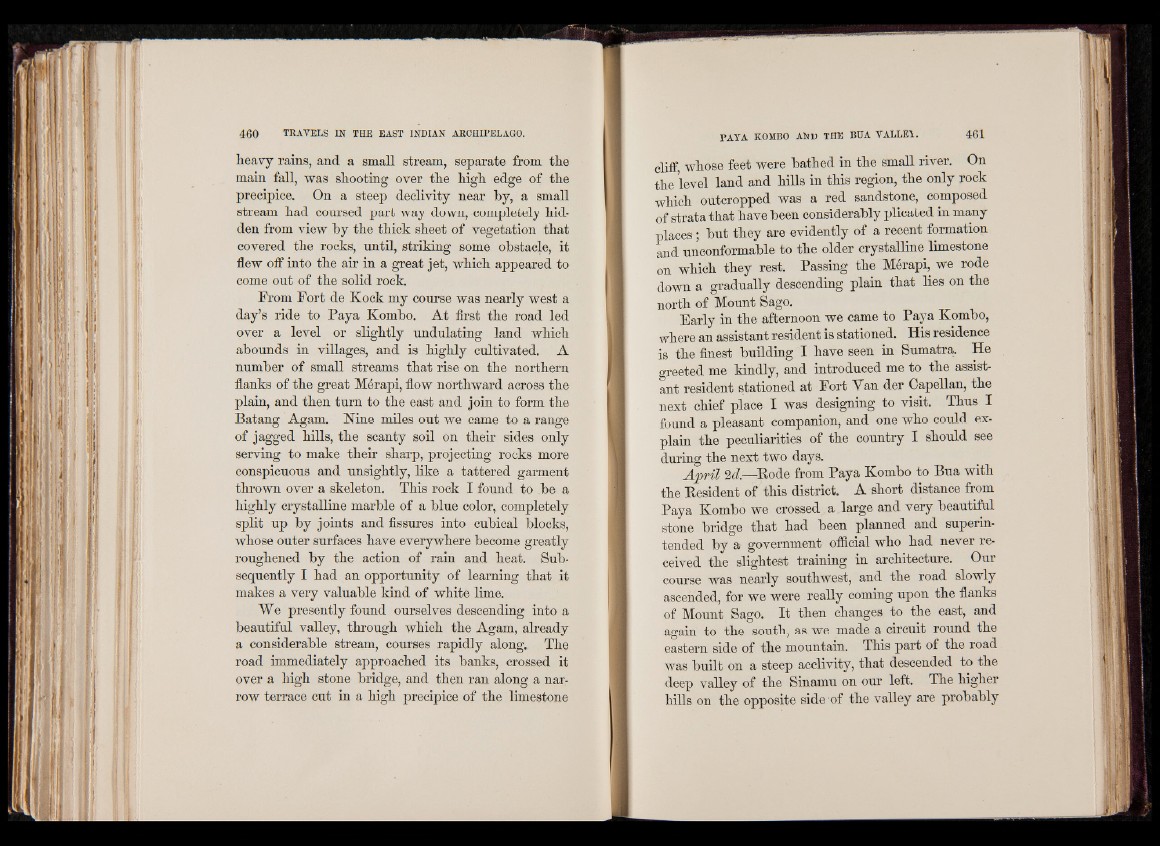
heavy rains, and a small stream, separate from the
main fall, was shooting over the high edge of the
precipice. On a steep declivity near by, a small
stream had coursed part way down, completely hidden
from view by the thick sheet of vegetation that
covered the rocks, until, striking some obstacle, it
flew off into the air in a great jet, which appeared to
come out of the solid rock.
From Fort de Kock my course was nearly west a
day’s ride to Paya Kombo. At first the road led
over a level or slightly undulating land which
abounds in villages, and is highly cultivated. A
number of small streams that rise on the northern
flanks of the great Merapi, flow northward across the
plain, and then turn to the east and join to form the
Batang Agam. Nine miles out we came to a range
of jagged hills, the scanty soil on their sides only
serving to make their sharp, projecting rocks more
conspicuous and unsightly, like a tattered garment
thrown over a skeleton. This rock I found to be a
highly crystalline marble of a blue color, completely
split up by joints and fissures into cubical blocks,
whose outer surfaces have everywhere become greatly
roughened by the action of rain and heat. Subsequently
I had an opportunity of learning that it
makes a very valuable kind of white lime.
We presently found ourselves descending into a
beautiful valley, through which the Agam, already
a considerable stream, courses rapidly along. The
road immediately approached its banks, crossed it
over a high stone bridge, and then ran along a narrow
terrace cut in a high precipice of the limestone
cliff, whose feet were bathed in the small river. On
the level land and hills in this region, the only rock
which outcropped was a red sandstone, composed
of strata that have been considerably plicated in many
places ; but they are evidently of a recent formation
and unconformable to the older crystalline limestone
on which they rest. Passing the Merapi, we rode
down a gradually descending plain that lies on the
north of Mount Sago.
Early in the afternoon we came to Paya Kombo,
where an assistant resident is stationed. His residence
is the finest building I have seen in Sumatra. He
greeted me kindly, and introduced me to the assistant
resident stationed at Fort Van der Capellan, the
next chief place I was designing to visit. Thus I
found a pleasant companion, and one who could explain
the peculiarities of the country I should see
during the next two days.
A p r il 2d.—Rode from Paya Kombo to Bua with
the Resident of this district. A short distance from
Paya Kombo we crossed a large and very beautiful
stone bridge that had been planned and superintended
by a government official who had never received
the slightest training in architecture. Our
course was nearly southwest, and the road slowly
ascended, for we were really coming upon the flanks
of Mount Sago. It then changes to the east, and
again to the south, as we made a circuit round the
eastern side of the mountain. This part of the road
was built on a steep acclivity, that descended to the
deep valley of the Sinamu on our left. The higher
hills on the opposite side of the valley are probably